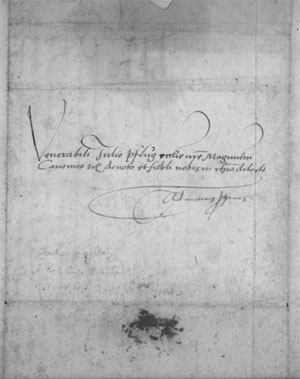Letter, Albert of Brandenburg to Julius Plüg (MSS 132)
This collection consists of a single, signed letter in German dated 30th July 1540. The letter is a request, addressed to Julius Plüg, to translate from Latin into German some articles on religion by Luther. A translation of the letter is enclosed with the original.
Albert of Brandenburg, Cardinal and Elector of the Holy Roman Empire, b. 28 June, 1490; d. 24 September, 1545. As early as 1509 he was Prebendary in the Cathedral of Mainz; Archbishop of Magdeburg and Administrator of Halberstadt from 1513; Archbishop of Mainz from 1514; and Cardinal-Priest from 1518. The Indulgence issued by Leo X in 1514 for the building of the new St. Peter's Cathedral in Rome was entrusted to Albert (1517) for publication in Saxony and Brandenburg. This commission has been made the ground of many accusations by d'Aubign and others against Albert and Leo X, as though they had used the Indulgence as a means of enriching themselves personally, "dividing beforehand the spoils of the credulous souls of Germany" (d'Aubigné History of the Reformation).
Albert employed Tetzel for the actual preaching of the Indulgence and furnished him a book of instructions:"Instructio summaria ad Subcommissarios P nitentiarum et Confessores." Later, Martin Luther addressed a letter of protest to Albert concerning the conduct of Tetzel, found fault with the Bishop's book of instructions and asked him to suppress it. Luther's charges are altogether groundless; the instructions of Albert to the preachers are both wise and edifying. Luther's letter was disregarded. Though many of the accusations against Albert's morals were likely false, Luther was probably justified in thinking that he would find in Albert a strong partisan.
The young bishop was somewhat worldly-minded, extravagant, better trained in humanistic studies than in theology, too much given to the patronage of learned men and artists. His long intimacy with Ulrich von Hutten is especially reprehensible. Leo X was obliged to send an admonition to Mainz because so many books hostile to the Faith were being published under the Bishop's eye. In later life Albert changed his conduct. In his diocese celebrated defenders of Catholicism were engaged; at Speyer and Ratisbon he met Blessed Peter Faber, S.J., and kept him in his diocese (1542-43); after this he was always a friend to the new order. Albert strove earnestly to introduce a more perfect system of religious instruction and brought forward measures for that purpose in the Diet of Nuremberg. He became by the sincerity of his zeal the great defender of the Faith in Germany. As a temporal prince, he ruled his electorate well; he introduced reforms in the administration of justice, into the police system, and into commerce. He was buried in the Cathedral of Mainz. An artistic memorial marks the resting-place of his remains.
Translation:
"Albert, [by the] mercy divine [in the] sacred Holy Roman Church
Cardinal and legate born [ruler of] Mainz and of Magdeburg
Archbishop Prince Elector Primate Administrator of Halber-
stadt Margrave of Brandenburg, etc.Our greeting first of all. Worthy and beloved friend, thoughtful and
faithful: Enclosed we send you a few Articles
pertaining to religion, which His Imperial Majesty
at Ghent has sent through Martin Luther,
and this day have arrived. Graciously we desire
that you translate these Articles into
the German language and a comfortable script,
and to send the same, along with your considered opinion and good judgment,
speedily to our hands. The decision
reached at the presently convening Diet at Haguenau we desire
to send you shortly as well. We will be pleased to receive
the gracious opinion you reveal.Dated at Aschaffenburg, the Friday after [the apostle St.] James' [Day] in the year '40 [July 30, 1540]
By his own hand he signed [this letter]."
The images below are available in a PDF document (1.8 MB).
Letter Address:

Letter Text (translation above):

For additional information about this collection, consult the finding aid.
Bibliography: The Catholic Encyclopaedia, Special edition; vol. I, Page 262. New York; The Encyclopedia Press, 1913.
